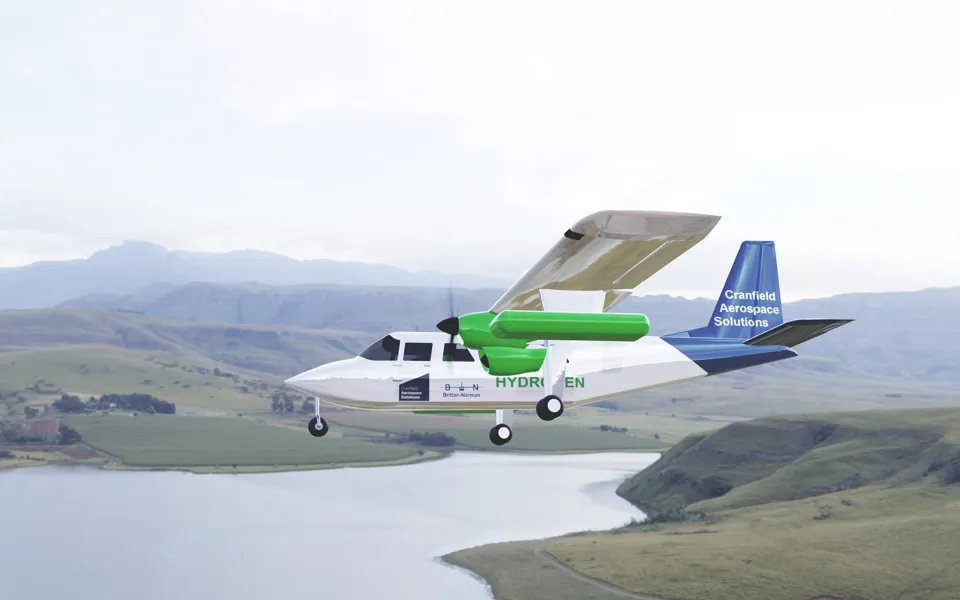
The role of hydrogen in the green aviation revolution
09 Mar 2023
Cranfield Aerospace Solutions’ Chief Executive Paul Hutton explains the role of hydrogen in the green aviation revolution.
The introduction of zero-emission aircraft will enable us to re-think our approach to regional connectivity and the way we currently fly. A recent report by Project NAPKIN stated that zero-carbon emission flight is entirely possible from the middle of this decade on sub-regional routes, on aircraft ranging in size from seven to 19 seats. The report also projected that it could be cost-effective to replace the entire UK regional fleet with safe, certified, zero-carbon emission larger aircraft by 2040, comprising 50 to 90 seats.
The 2022 Aerospace Technology Institute’s FlyZero study and Airbus’s 2022 technology summit both showed that significant research and development progress is being made with larger aircraft powered by hydrogen. Indeed, hydrogen combustion could potentially be used by larger aircraft from the mid-2030s.
But we do not have to wait until then. There is an immediate role for hydrogen – and it will start small. Along with Ricardo’s expertise in fuel cell technology, we are working to convert the propulsion system of a Britten-Norman Islander nine-seat aircraft to gaseous hydrogen. Our goal is to bring it into commercial service by 2026, flying routes of up to 200 kilometres.
We are encouraged that greater consideration for the sub-regional element of air travel is now taking place. Adjusting to net-zero aviation by 2050 (and even more stringent targets in certain countries) means operators across the world are viewing shorter journeys in a fresh light. Newer, sub-regional routes, relying on smaller, zero-emission aircraft flying from smaller airports close to the communities they serve, are increasingly being viewed as crucial building blocks and a way to prove hydrogen technology before it is matured to larger aircraft.
Resurrecting sub-regional airports
Air New Zealand is leading the way in considering how shorter routes could be served by smaller, zero-emission aircraft where traditionally much larger aircraft have been used, albeit inefficiently. At Cranfield Aerospace Solutions we are delighted to be the sole hydrogen-powered aircraft partner of Air New Zealand’s Mission Next Gen Aircraft, the flag carrier’s ambitious zero-emission aircraft programme. We will be working with three other companies worldwide to support Air New Zealand’s mission to have its first zero-emission demonstrator flight in the sky from 2026.
This rethink will, of course, have knock-on effects to fleet management and operational models. But in this new age of aviation, everything needs to be reassessed. And with kerosene prices predicted to rise significantly as a result of carbon taxes and the price of hydrogen predicted to fall as more renewable energy comes on stream for production, the cost equation is now changing.
Further investigation should also be given to how many sub-regional airports could be resurrected to serve sub-regional passenger services. In many cases the infrastructure is already there – it just needs an upgrade, and could additionally create a local hydrogen generation hub, powering not only the aircraft but the airport itself and possibly the surrounding community.
From an industrial competitiveness point of view, whichever nation takes a lead on delivering these early sub-regional green aircraft will have a significant strategic advantage over their competitors. The UK Government is sending the right signal with the publication and now implementation of its ‘Jet Zero’ strategy, setting out how we will achieve net-zero aviation by 2050. But there needs to be a greater sense of urgency.
Policy can drive innovation and, through innovation, the world has a unifying pathway towards addressing the climate emergency while multiplying jobs and creating economic opportunities. Countries like the UK can flatten the research and development curves of the technologies, drive down costs and make adoption easier on a global scale.
The importance of targets
Targets are essential to help sustain the momentum required to reach our environmental goals. It is encouraging that in aviation stringent targets are not only being agreed upon, but some nations are choosing to set even more challenging ones. The International Civil Aviation Organisation’s long-term global aspiration of net-zero carbon emissions by 2050 marks a turning point, by providing an international policy framework for the global aviation community to adhere to. But this should only be considered as the bare minimum.
There is much ground to cover between now and 2050 and many countries are throwing down the gauntlet to industry by implementing more near-term targets. Take, for example, the US states of California and Hawaii, both of which require net zero to be reached by 2045. In terms of aviation, Norway has a target of zero-emission internal flights by 2040 and the UK Government also intends to consult next year on a target for domestic flights to reach net zero by 2040.
These targets clearly demonstrate the commitment to decarbonise aviation and have an important signalling effect in driving industry – and associated investment – to accelerate sustainability developments.
The road to true zero-emission aircraft will be complex. Different technologies will coexist for a period until a complete switch to zero-carbon and zero-emissions aviation can be achieved. But whatever the technology, there must be no let-up in pace: as an industry we must not be complacent. We must assume that eventually governments will intervene in response to public pressure and curtail air traffic volumes if the aviation sector does not meet its environmental goals.
We must all play our part, too – on the small scale and on the large, collaborating at home and with our compatriots on the other side of the globe.
Project NAPKIN – towards a UK hydrogen flight network
Project NAPKIN (New Aviation, Propulsion, Knowledge and Innovation Network) brings together three airports/airport groups (Heathrow, London City, Highlands and Islands), three manufacturers (GKN Aerospace, Rolls-Royce, Cranfield Aerospace Solutions) and three academic institutions (University College London, Cranfield University and the University of Southampton).
Its recent report, ‘Making Zero-Carbon Emission Flight a Reality in the UK’, evaluates 25 modified and original aircraft concepts to explore their impact on the five ‘As’ of Aircraft, Airport, Airspace, Airline and Air Passenger. By taking a whole systems approach, the project sheds light on ground infrastructure, energy demand, noise performance and emerging passenger sentiment.
Project NAPKIN sets out how a UK hydrogen flight network can be achieved, taking account of aircraft capability, routes, commercial viability and scale. This shows where green hydrogen-powered aircraft can successfully be adopted in realistic market conditions.




 Follow Ricardo plc for regular updates
Follow Ricardo plc for regular updates




